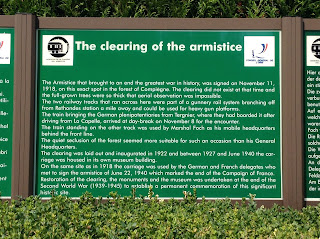Day 1 - August 28: On the Somme
Day 1 - Aug 28: On the Somme
Today we arrived at the Charles de Gaulle airport, grabbed a rental car and drove to Compiegne, France. France is beautiful with its picturesque rolling hills and villages with narrow roads lined with brick buildings...it's like something you see in a book or in a movie. It is so surreal to be on the freeway reading destination sign posts indicating towns where great battles took place that I had read about: Arras, Cambrai, Amiens, ...Armistice Clearing - Compiegne
 It was in Compiegne that we saw the Armistice Clearing. On 8 November 1918 the Allied Supreme Commander French Marshall Koch along with additional French and Allied representatives met with a German delegation to sign the Armistice ending the Great War in this very location in a railcard similar to the one on display.
It was in Compiegne that we saw the Armistice Clearing. On 8 November 1918 the Allied Supreme Commander French Marshall Koch along with additional French and Allied representatives met with a German delegation to sign the Armistice ending the Great War in this very location in a railcard similar to the one on display.
In Bill's words: "Ironically on 21 June 1940 Adolf Hitler “gleefully” accepted the capitulation of France from Marshal Petain in the same car, then had it shipped to Germany to be destroyed". The carriage in the museum is an identical model.

On the same grounds is displayed a statue of Marshal Foch
At the entrance to the clearing stands the Monument to the Heroic Soldiers of France depicting a fallen German eagle with a sword embedded in it. Hitler ordered this destroyed as well. The monument was restored using the original stones brought back from Germany.
Villers-Carbonnel

We visited our first war cemetery - a French cemetery at Villers Carbonnel. The cemetery holds the bodies of 2285 soldiers who died for France mostly from WWI. Of those only 990 soldiers have individual graves. Two ossuaries hold the mortal remains of 1295 soldiers and the remains of an additional 1201 soldiers that could not be identified. Very touching
La Chapellette British and Indian Cemetery, Perrone
577 Casualties, 0 Canadians, 6 Unidentified
On our way to Perrone we came across the La Chapellette British and Indian cemetery from WWI. Bill was amazed in that the Indian soldiers always wanted to be cremated, never buried. I was amazed at the number of graves there were of soldiers who were 19, 20, 21 years old....they had so much more living to do!
I would soon discover that throughout France and Belgium cemeteries would crop up on the roadsides along our way. There are so many... too many!
The Great War Museum, Perrone.
Set in an old castle it had a great number of artifacts from WWI and an incredible amount of articles, pictures, propaganda from the days leading up to the war and the war itself. Very interesting!

Inside was a painting of the Basilique Notre-Dame de Brebieres in Albert from the Great War. The Germans used the basilica to sight in their artillery guns. The golden statue of Mary and baby Jesus was dubbed the Golden Virgin. As a result of the damage to the basilica the statue leaned greater than 90 degrees from its original position atop the spire without falling.The British believed that whichever side knocked down the Leaning Virgin would lose the war.
Australian War Memorial at Pozieres.

The 2nd Australian Division were involved in a fierce battle at Mount St. Quentin in August 1918. A monument in their honour was erected in Pozieres.
The original monument was removed and destroyed by the German SS in 1940. I guess they didn't appreciate the depiction of an ANZAC soldier impaling a German Eagle.
The ANZACs were also known as tough soldiers and fought very bravely as the Canadians did. Their contributions to the war effort are equally recognized throughout France and Belgium.
Guillemont Road Cemetery.
2265 Casualties, 1 Canadian (Nfld Rgt), 1521 Unidentied
The cemetery is incredibly peaceful perched over gently sloping farmland.
I was struck by the number of grave markers that said merely "A Soldier of the Great War" and below the cross "Known Unto God". These were the graves of the soldiers who could not be identified, listed only as Missing in Action. I later discovered that sadly enough, this is quite common in the war cemeteries.
One significant grave here is that of Lieutenant Raymond Asquith killed 15 September 1916. He was the son of the Prime Minister of England Herbert Henry Asquith, The pressures of the war weighed heavily on Asquith but losing his son caused him so much grief that he resigned as PM in December of 1916. David Lloyd George succeeded Asquith as Britain's Prime Minister.
We finished the day by checking into our B&B in Mailly-Maillet and grabbing dinner in Albert. Afterwards we took a quick visit to the basilica - long since rebuilt with all its grandeur.
Photos may not be used for commercial purposes without permission.







Wow I'm very jealous! Lots of cool information
ReplyDelete